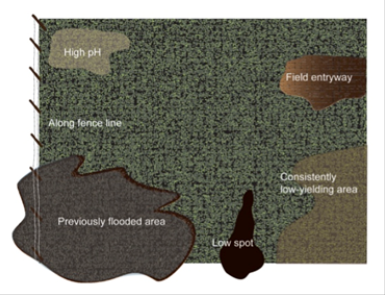|
|
It’s time to begin planning for the next growing season and for soybeans, that means taking soil samples to determine SCN population densities. Fall is a perfect time to do this.
3 Reasons to Do It Now
-
Fall soil sampling for SCN may reveal that the nematode was responsible for disappointingly low soybean yields in 2012, although it may be difficult to separate this from low yields due to drought conditions and other diseases and insect pests.
-
Fall soil sampling will reveal if SCN-resistant soybean varieties should be grown in 2013. If SCN has not been discovered in a field before, areas where the nematode can be first found in soil samples include near field entryways, in low spots and in high pH areas (see Figure1).
- Prolonged use of SCN-resistant soybean varieties with the common, PI 88788 source of resistance can lead to unintentional build-up of SCN population densities in the soil, increasing the amount of damage caused by the nematode in future years. It is a good idea to determine the SCN population density in fields where SCN-resistant soybean varieties with the common, PI 88788 source of resistance have been grown for numerous years. In this case, soil sampling for SCN every six to eight years is adequate, depending on how frequently soybeans are grown (sample after every three orfour soybean crops).
-
Collecting Soil Samples – 7 Steps
- Collect 8-inch-long soil cores and with 15 to 20 soil cores per sampling area.
- Limit the area sampled to 20 acres or so, if possible.
- Take numerous multiple-core samples from different areas in large fields.
- If grid sampling, obtain one or two soil cores from every grid cell and combine cores from the number of cells that represent approximately 20 acres.
- Gather cores from underneath crop row if soybeans were grown this season.
- Do not collect samples if the soil is muddy or frozen.
-
Send samples to a private soil-testing laboratory that does SCN testing or to:
Plant and Insect Diagnostic Clinic
Iowa State University
327 Bessey Hall
Ames, IA 50011

 Figure 1. Areas of a field where soybean cyst nematode might first be discovered in soil samples.
Figure 1. Areas of a field where soybean cyst nematode might first be discovered in soil samples.




Post a comment
Report Abusive Comment